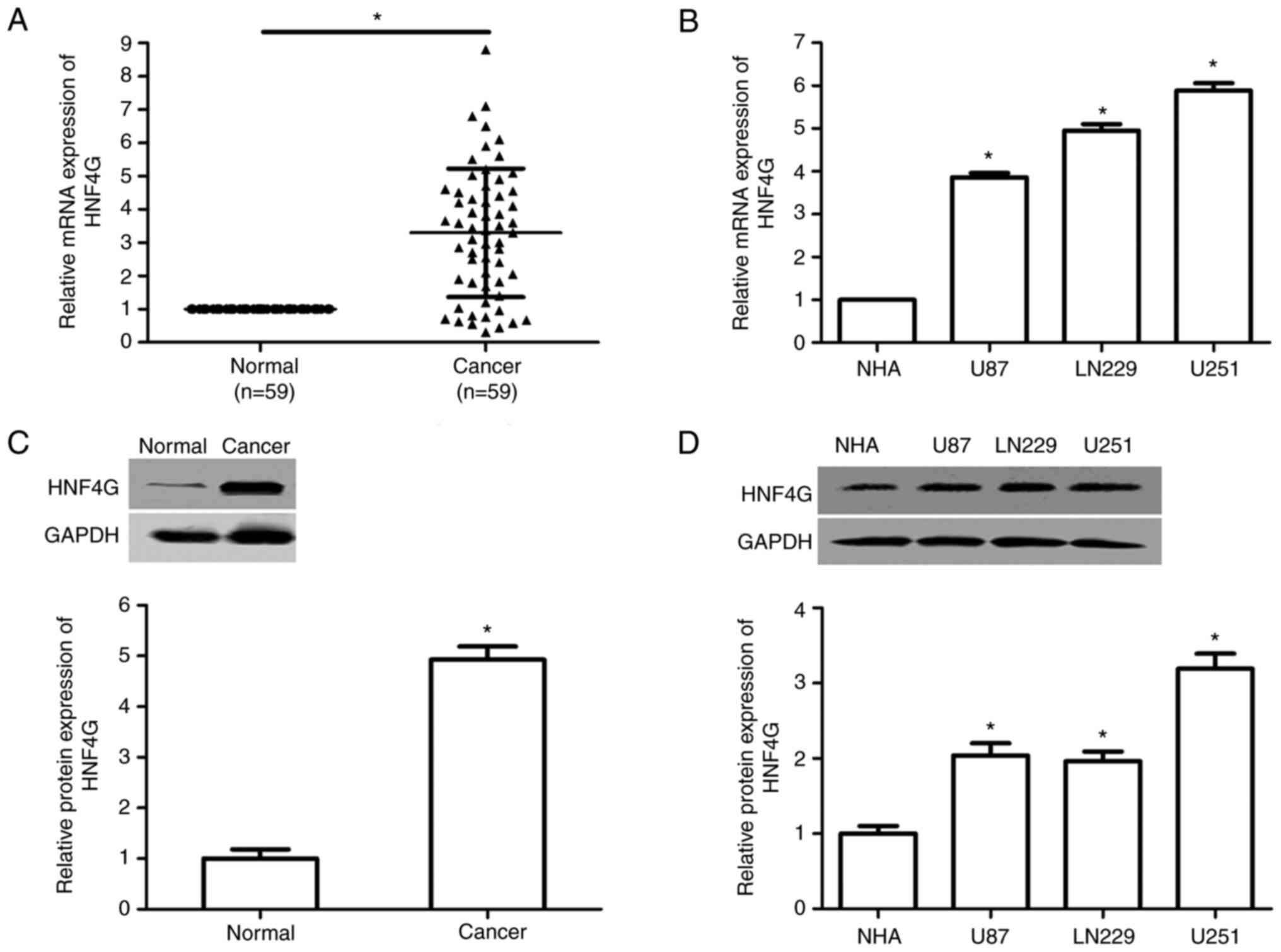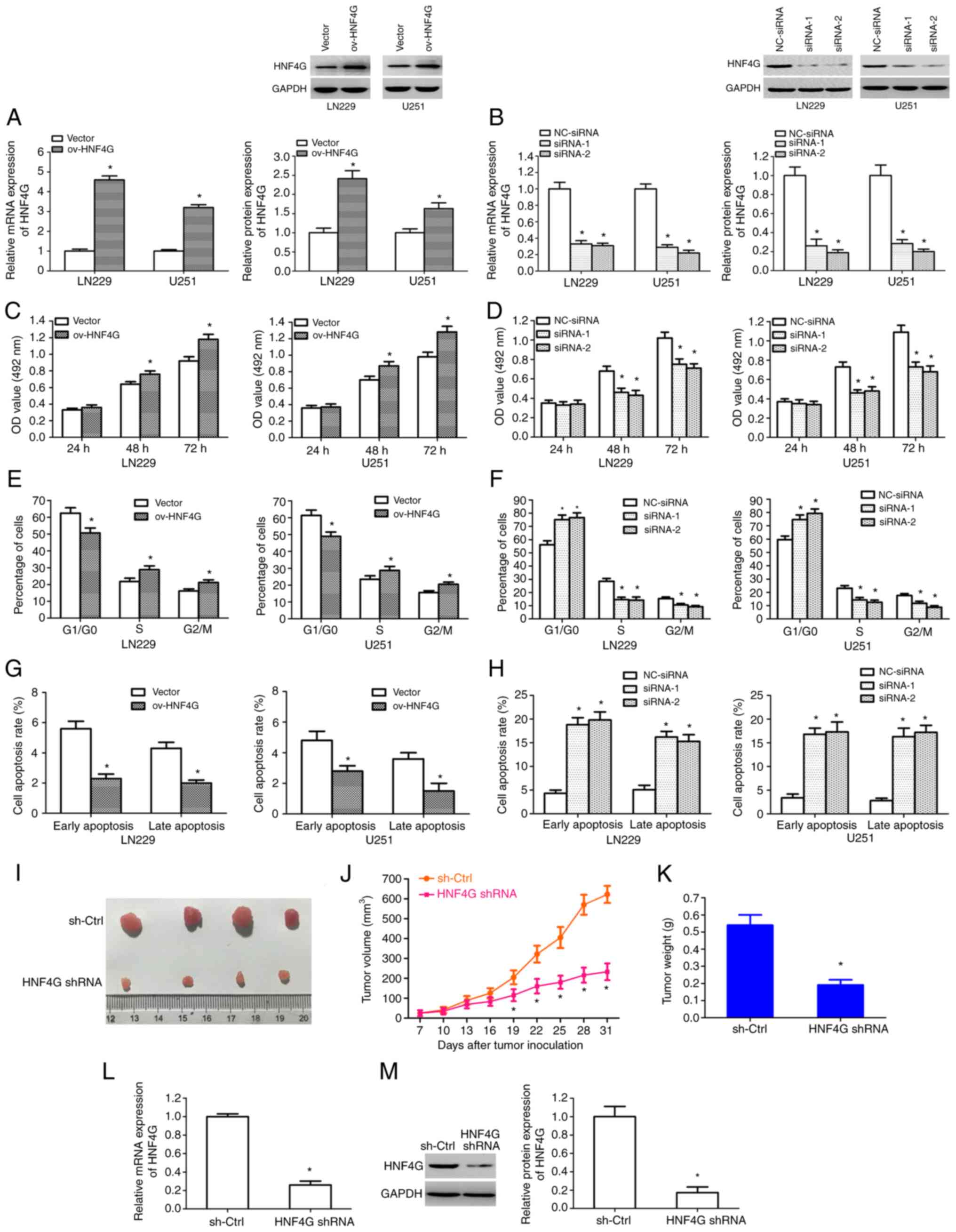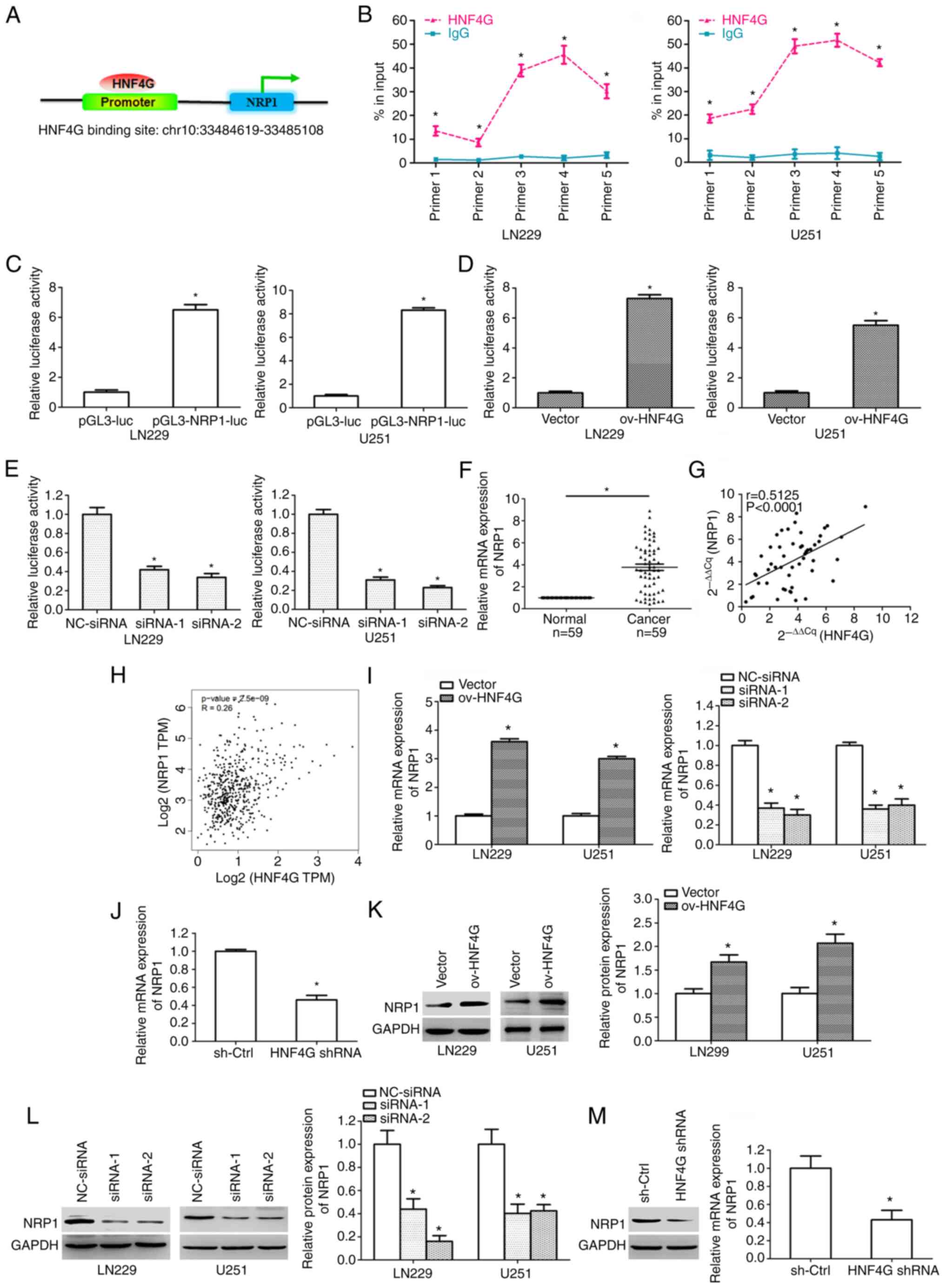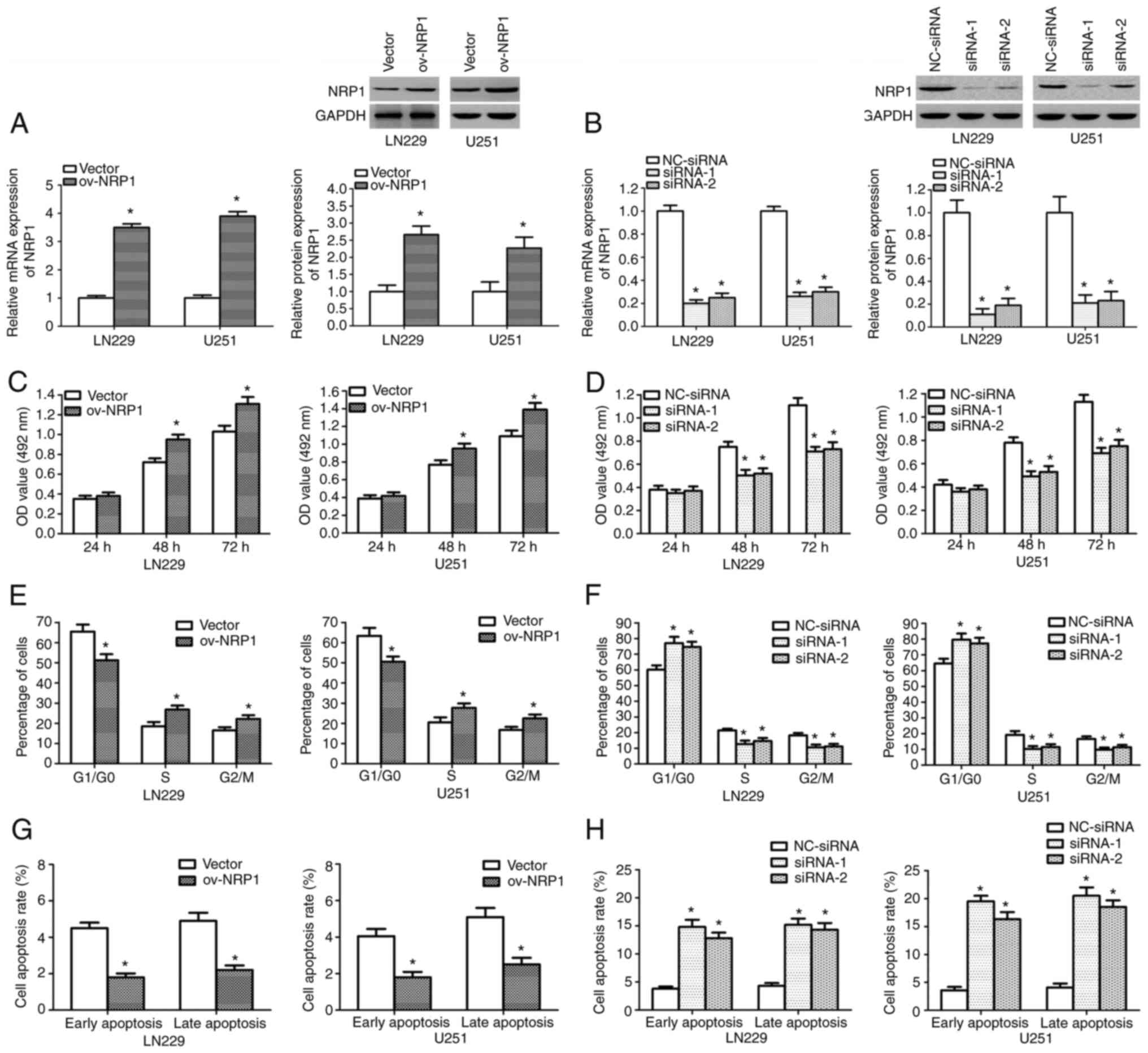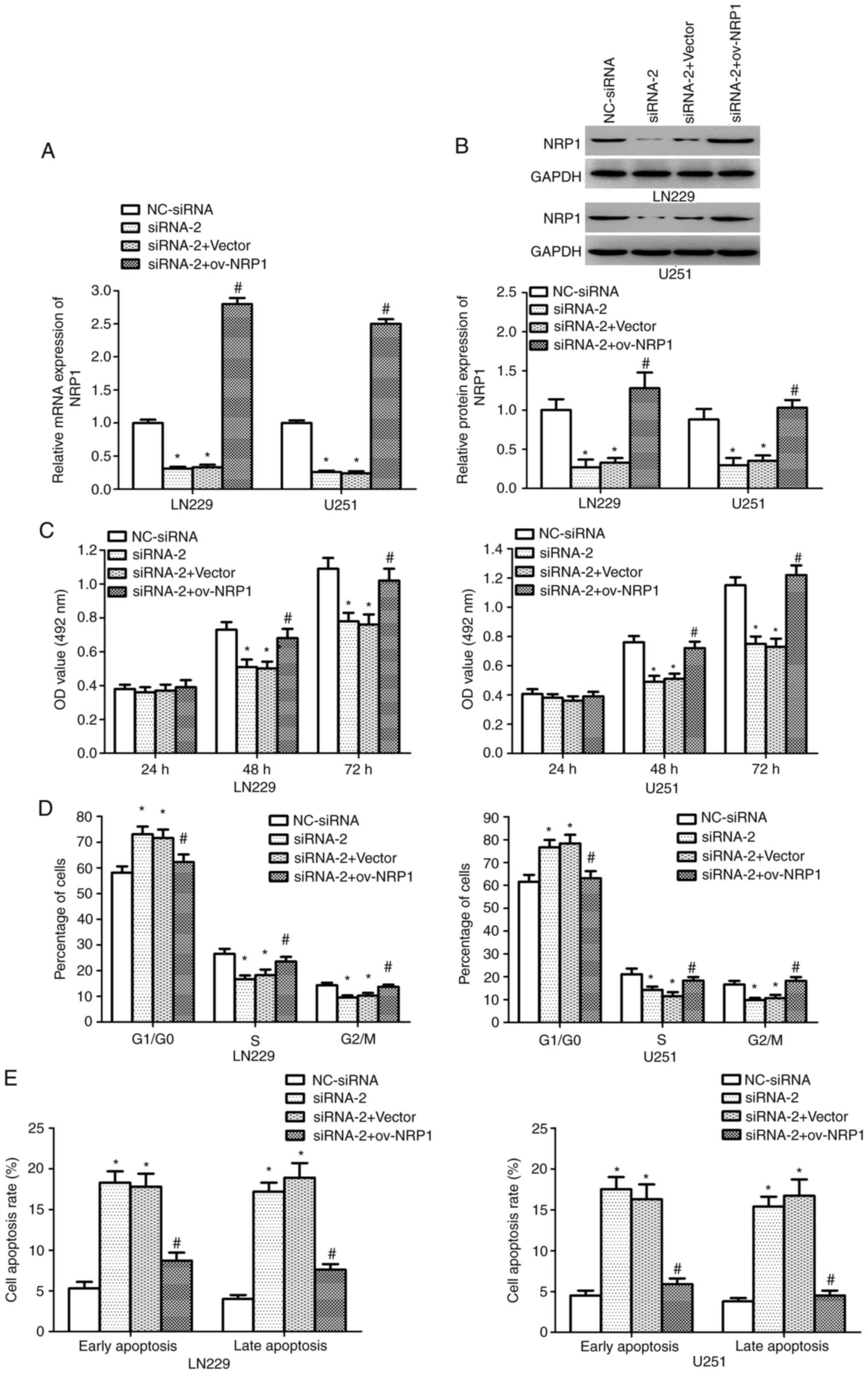|
1
|
Chen J, Wu X, Xing Z, Ma C, Xiong W, Zhu X
and He X: FOXG1 expression is elevated in glioma and inhibits
glioma cell apoptosis. J Cancer. 9:778–783. 2018. View Article : Google Scholar : PubMed/NCBI
|
|
2
|
Ostrom QT, Cote DJ, Ascha M, Kruchko C and
Barnholtz-Sloan JS: Adult glioma incidence and survival by race or
ethnicity in the United States from 2000 to 2014. JAMA Oncol.
4:1254–1262. 2018. View Article : Google Scholar : PubMed/NCBI
|
|
3
|
Komori T, Sasaki H and Yoshida K: Revised
WHO classification of tumours of the central nervous system:
Summary of the revision and perspective. No Shinkei Geka.
44:625–635. 2016.PubMed/NCBI
|
|
4
|
Bertrand S, Brunet FG, Escriva H,
Parmentier G, Laudet V and Robinson-Rechavi M: Evolutionary
genomics of nuclear receptors: From twenty-five ancestral genes to
derived endocrine systems. Mol Biol Evol. 21:1923–1937. 2004.
View Article : Google Scholar : PubMed/NCBI
|
|
5
|
Drewes T, Senkel S, Holewa B and Ryffel
GU: Human hepatocyte nuclear factor 4 isoforms are encoded by
distinct and differentially expressed genes. Mol Cell Biol.
16:925–931. 1996. View Article : Google Scholar : PubMed/NCBI
|
|
6
|
Baraille F, Ayari S, Carrière V, Osinski
C, Garbin K, Blondeau B, Guillemain G, Serradas P, Rousset M,
Lacasa M, et al: Glucose tolerance is improved in mice invalidated
for the nuclear receptor HNF-4γ: A critical role for
enteroendocrine cell lineage. Diabetes. 64:2744–2756. 2015.
View Article : Google Scholar : PubMed/NCBI
|
|
7
|
Chen BD, Chen XC, Pan S, Yang YN, He CH,
Liu F, Ma X, Gai MT and Ma YT: TT genotype of rs2941484 in the
human HNF4G gene is associated with hyperuricemia in Chinese Han
men. Oncotarget. 8:26918–26926. 2017. View Article : Google Scholar : PubMed/NCBI
|
|
8
|
Wang C, Zhang T, Liao Q, Dai M, Guo J,
Yang X, Tan W, Lin D, Wu C and Zhao Y: Metformin inhibits
pancreatic cancer metastasis caused by SMAD4 deficiency and
consequent HNF4G upregulation. Protein Cell. 12:128–144. 2021.
View Article : Google Scholar : PubMed/NCBI
|
|
9
|
Shukla S, Cyrta J, Murphy DA, Walczak EG,
Ran L, Agrawal P, Xie Y, Chen Y, Wang S, Zhan Y, et al: Aberrant
activation of a gastrointestinal transcriptional circuit in
prostate cancer mediates castration resistance. Cancer Cell.
32:792–806.e7. 2017. View Article : Google Scholar : PubMed/NCBI
|
|
10
|
Okegawa T, Ushio K, Imai M, Morimoto M and
Hara T: Orphan nuclear receptor HNF4G promotes bladder cancer
growth and invasion through the regulation of the hyaluronan
synthase 2 gene. Oncogenesis. 2:e582013. View Article : Google Scholar : PubMed/NCBI
|
|
11
|
Wang J, Zhang J, Xu L, Zheng Y, Ling D and
Yang Z: Expression of HNF4G and its potential functions in lung
cancer. Oncotarget. 9:18018–18028. 2017. View Article : Google Scholar : PubMed/NCBI
|
|
12
|
Wang Z, Ni F, Yu F, Cui Z, Zhu X and Chen
J: Prognostic significance of mRNA expression of CASPs in gastric
cancer. Oncol Lett. 18:4535–4554. 2019.PubMed/NCBI
|
|
13
|
Livak KJ and Schmittgen TD: Analysis of
relative gene expression data using real-time quantitative PCR and
the 2(−Delta Delta C(T)) method. Methods. 25:402–408. 2001.
View Article : Google Scholar : PubMed/NCBI
|
|
14
|
Kent WJ, Sugnet CW, Furey TS, Roskin KM,
Pringle TH, Zahler AM and Haussler D: The human genome browser at
UCSC. Genome Res. 12:996–1006. 2002. View Article : Google Scholar : PubMed/NCBI
|
|
15
|
Sun H, Tian J, Xian W, Xie T and Yang X:
miR-34a inhibits proliferation and invasion of bladder cancer cells
by targeting orphan nuclear receptor HNF4G. Dis Markers.
2015:8792542015. View Article : Google Scholar : PubMed/NCBI
|
|
16
|
Chen L, Toke NH, Luo S, Vasoya RP, Fullem
RL, Parthasarathy A, Perekatt AO and Verzi MP: A reinforcing
HNF4-SMAD4 feed-forward module stabilizes enterocyte identity. Nat
Genet. 51:777–785. 2019. View Article : Google Scholar : PubMed/NCBI
|
|
17
|
Hong TM, Chen YL, Wu YY, Yuan A, Chao YC,
Chung YC, Wu MH, Yang SC, Pan SH, Shih JY, et al: Targeting
neuropilin 1 as an antitumor strategy in lung cancer. Clin Cancer
Res. 13:4759–4768. 2007. View Article : Google Scholar : PubMed/NCBI
|
|
18
|
Karjalainen K, Jaalouk DE, Bueso-Ramos CE,
Zurita AJ, Kuniyasu A, Eckhardt BL, Marini FC, Lichtiger B, O'Brien
S, Kantarjian HM, et al: Targeting neuropilin-1 in human leukemia
and lymphoma. Blood. 117:920–927. 2011. View Article : Google Scholar : PubMed/NCBI
|
|
19
|
Gelfand MV, Hagan N, Tata A, Oh WJ,
Lacoste B, Kang KT, Kopycinska J, Bischoff J, Wang JH and Gu C:
Neuropilin-1 functions as a VEGFR2 co-receptor to guide
developmental angiogenesis independent of ligand binding. Elife.
3:e037202014. View Article : Google Scholar : PubMed/NCBI
|
|
20
|
Gu C, Rodriguez ER, Reimert DV, Shu T,
Fritzsch B, Richards LJ, Kolodkin AL and Ginty DD: Neuropilin-1
conveys semaphorin and VEGF signaling during neural and
cardiovascular development. Dev Cell. 5:45–57. 2003. View Article : Google Scholar : PubMed/NCBI
|
|
21
|
Bagri A and Tessier-Lavigne M: Neuropilins
as semaphorin receptors: In vivo functions in neuronal cell
migration and axon guidance. Adv Exp Med Biol. 515:13–31. 2002.
View Article : Google Scholar : PubMed/NCBI
|
|
22
|
Pan Q, Chanthery Y, Liang WC, Stawicki S,
Mak J, Rathore N, Tong RK, Kowalski J, Yee SF, Pacheco G, et al:
Blocking neuropilin-1 function has an additive effect with
anti-VEGF to inhibit tumor growth. Cancer Cell. 11:53–67. 2007.
View Article : Google Scholar : PubMed/NCBI
|
|
23
|
Sulpice E, Plouët J, Bergé M, Allanic D,
Tobelem G and Merkulova-Rainon T: Neuropilin-1 and neuropilin-2 act
as coreceptors, potentiating proangiogenic activity. Blood.
111:2036–2045. 2008. View Article : Google Scholar : PubMed/NCBI
|
|
24
|
Jia H, Cheng L, Tickner M, Bagherzadeh A,
Selwood D and Zachary I: Neuropilin-1 antagonism in human carcinoma
cells inhibits migration and enhances chemosensitivity. Brit J
Cancer. 102:541–552. 2010. View Article : Google Scholar : PubMed/NCBI
|
|
25
|
Lee P, Goishi K, Davidson AJ, Mannix R,
Zon L and Klagsbrun M: Neuropilin-1 is required for vascular
development and is a mediator of VEGF-dependent angiogenesis in
zebrafish. Proc Natl Acad Sci USA. 99:10470–10475. 2002. View Article : Google Scholar : PubMed/NCBI
|
|
26
|
Raskopf E, Vogt A, Standop J, Sauerbruch T
and Schmitz V: Inhibition of neuropilin-1 by RNA-interference and
its angiostatic potential in the treatment of hepatocellular
carcinoma. Z Gastroenterol. 48:21–27. 2010. View Article : Google Scholar : PubMed/NCBI
|
|
27
|
Matsushita A, Götze T and Korc M:
Hepatocyte growth factor-mediated cell invasion in pancreatic
cancer cells is dependent on neuropilin-1. Cancer Res.
67:10309–10316. 2007. View Article : Google Scholar : PubMed/NCBI
|
|
28
|
Song Y, Zeng S, Zheng G, Chen D, Li P,
Yang M, Luo K, Yin J, Gu Y, Zhang Z, et al: FOXO3a-driven miRNA
signatures suppresses VEGF-A/NRP1 signaling and breast cancer
metastasis. Oncogene. 40:777–790. 2021. View Article : Google Scholar : PubMed/NCBI
|
|
29
|
Zheng Y, Wang C, Song A, Jiang F, Zhou J,
Li G, Zhang W, Ye J, Ding X, Zhang W, et al: CMTM6 promotes cell
proliferation and invasion in oral squamous cell carcinoma by
interacting with NRP1. Am J Cancer Res. 10:1691–1709.
2020.PubMed/NCBI
|
|
30
|
Mei B, Chen J, Yang N and Peng Y: The
regulatory mechanism and biological significance of the
Snail-miR590-VEGFR-NRP1 axis in the angiogenesis, growth and
metastasis of gastric cancer. Cell Death Dis. 11:2412020.
View Article : Google Scholar : PubMed/NCBI
|
|
31
|
Huang Z, Cheng C, Xiong H, Wang Y, Chen
KK, Yang J, Xiao B, Zhang R, Li S and Sang Y: NRP1 promotes cell
migration and invasion and serves as a therapeutic target in
nasopharyngeal carcinoma. Int J Clin Exp Pathol. 11:2460–2469.
2018.PubMed/NCBI
|
|
32
|
Evans IM, Yamaji M, Britton G, Pellet-Many
C, Lockie C, Zachary IC and Frankel P: Neuropilin-1 signaling
through p130Cas tyrosine phosphorylation is essential for growth
factor-dependent migration of glioma and endothelial cells. Mol
Cell Biol. 31:1174–1185. 2011. View Article : Google Scholar : PubMed/NCBI
|
|
33
|
Higgins DMO, Caliva M, Schroeder M,
Carlson B, Upadhyayula PS, Milligan BD, Cheshier SH, Weissman IL,
Sarkaria JN, Meyer FB and Henley JR: Semaphorin 3A mediated brain
tumor stem cell proliferation and invasion in EGFRviii mutant
gliomas. BMC Cancer. 20:12132020. View Article : Google Scholar : PubMed/NCBI
|
|
34
|
Hamerlik P, Lathia JD, Rasmussen R, Wu Q,
Bartkova J, Lee M, Moudry P, Bartek J Jr, Fischer W, Lukas J, et
al: Autocrine VEGF-VEGFR2-neuropilin-1 signaling promotes glioma
stem-like cell viability and tumor growth. J Exp Med. 209:507–520.
2012. View Article : Google Scholar : PubMed/NCBI
|















